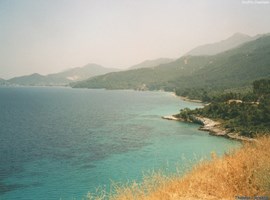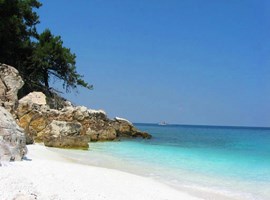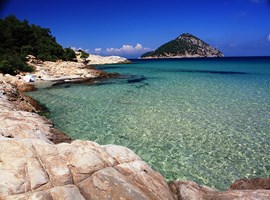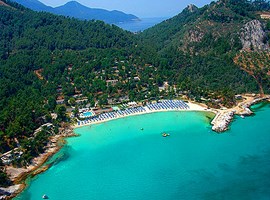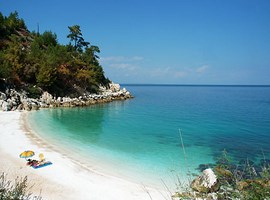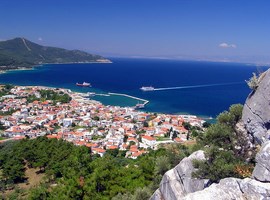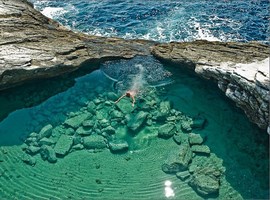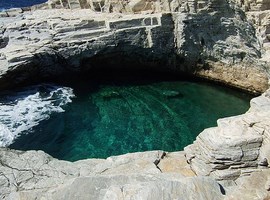The island of Thassos is located on the Northern Aegean Sea, at about 10 miles south from the city of Kavala, one of the most beautiful cities of Macedonia & Thrace in Greece. A place of irresistible natural beauty, with an interesting and rich fauna and a wonderful flora. Thassos looks like a forest on water as most of its surface is covered by pine forests and beautiful olive groves. Thassos is believed to have been named from Thassos who was one of the offsprings of Aginoras, the king of Phoenicia. Thassos came in the island during his research in Europe and he established himself there as the first king. Other ancient sources support that other appellations of the island, such as Hieria comes from the chill summer breeze Athria, as Coast of Goddess Demetra thanks to the fertile ground of the island or Dasos which means forest in Greek thanks to the many forests on the island.
Ancient years of Thassos
According to Herodotus, the island of Thassos was constructed by the Phoenicians with Thassos as their king, who came to the island even before the Parians. The Phoenicians drove away the Thracians, who were till then the inhabitants of the island, and started to work with the mineral mining, as the island was rich in minerals. The Phoenicians also developed the naval engineering and shipping activities along with agriculture and they also built a fortress around the main town of the island. In order to assist with these activities, Greeks and other tribes came to the island which in time started turning into an autonomous state out of the Phoenician control. The predominant element of the island was now the Greek element. The island flourished in manufacturing, mineral mining, industrial production but also arts and culture. At the end of the archaic period, the inhabitants had built a state-of-the art wall around its town, made with marble and slate revealing the town’s prosperity. The wall had to be torn down by the Thassians themselves after the Persians invaded the area but it was partially rebuilt in 412 B.C.
In the following years and due to the Peloponnesian War the island is utilized by Athenians and it gradually loses its autonomy till around 385 B.C. when she regained its own control. But it was a short period of recovery since it finally yielded to Philippe II of Macedonia in 338 B.C.
Hellenistic Period
During the Macedonian rule the island manages to keep a basic autonomy. During that period the inhabitants restore their temples and their fortified walls and an outburst of constructions and various wide and well organized settlements emerge throughout the island. It was indeed the most important period of construction and development of building activities.
Other conquerors
Thassos, like most parts of Greece, came under the Byzantine rule at the time when the Byzantine Empire was flourishing. When the island came under the Byzantines the state of Thassos lost its power and Christianism started expanding rapidly although the authorities did not want to disappoint the Roman Empire. In the first phase of Byzantine rule the island became pretty prosperous but this declined as the empire’s enemies started raiding Thassos. Thassos was part of the Byzantine Empire, with intervals, till the 14th century A.D. when the Venetians took the authority. During this time the island and its commercial activities flourished until Sicilians, Slavs, Greek and Spanish pirates devastated all the development and positive progress of most fields during the last centuries. Finally, at about 1455 AC and after the destruction of the Byzantine Empire, the Turks took over the island and left it almost uninhabited as almost all its inhabitants were transferred to Constantinople.
After years of harsh domination and cruel tax systems the Russian fleet defeated the Turks and a ship came to the island which was liberated only for four years. When the Sultan returned to the island’s domination, his oppression and cruelty was much harder till the beginning of the 19th century when the Sultan gave the island as a reward to the Egyptian Mehmet Ale. He was pretty fond of the island and let the inhabitants create their own governance system made by communities.
Finally Thassos was shortly liberated during the Greek Revolution in 1821 but this only briefly as the Neo-Turks re-established their constitution and all the rights and privileges of the island were taken away from them till the Balkan Wars in 1912, when Thassos was finally free.
Thassos sightseeing
Thassos Acropolis
The Acropolis of Thassos is located outside the modern town of Thassos and is a structure from the Byzantine years which was strengthened and developed much more during the Venetian occupation. Acropolis is made of three levels; the middle one hosts a temple for the goddess Athena while the third one, despite being the simplest of all, was the temple of Pan, one of God Dionysus most faith followers. A sculptured portrait of him playing his Syrinx graces the place which is the favourite of the visitors. You should absolutely visit the Acropolis of Thassos just to enjoy the breath-taking view and breathe its historical air.
Thassos Ancient Town
Right next to Thassos town lay the remains of the ancient settlement of the island which hosts two ports, the military one, closed to public and ships other than military ships, and the commercial one, used for the town’s commercial activities. The Agora (means in Greek market) the centre of the politics, administrative and financial activities, is among the most important discoveries which have taken place on the island. The area hosts a great variety of beautiful statues, sculptures and inscriptions of remarkable value while the most of them are exhibited today at the Museum of Louvre as the excavations that brought them to light was conducted in 1911 by the Archaeological Faculty of France. The ancient building of the Odeon and the ancient theatre, the temple of Zeus and Artemis are also among the main parts of the place.
Peninsula Of Aliki
The remains of an ancient settlement and an ancient temple has been found here since the 7th century BC while the settlement is believed to have been very wealthy thanks to its marble mining activities and that’s why the Christians moved here during the Byzantine times and built two big churches (basilica) in the place of a prehistoric necropolis. A marble street was using to connect Aliki with the ancient town of Thassos, parts of which are still visible in the villages of Dermata and Petradi. Also, a half immersed mining area is still visible there as the activity was interrupted steeply due to a sudden event, most possible by an earthquake some time either during the 4th or the 6th century AC.
Thassos Ancient Theatre
A marvellous piece of the ancient architecture, the Thassos ancient theatre still lies right next to the island’s town emitting the majesty of the past cultural activities. The theatre was built probably in the 5th century BC and it was used for various cultural events even during the Roman era hosting dramas, theatrical plays and musical performances. In some seats the inscribed names are visible even today, a fact which proves that people used to reserve their seat in order to watch an event. Parts of the theatre were decorated with the unique beauty and colour of the Thassian marble which is still obvious.
Olives and Olive Oil Museum
Right outside the settlement of Skala Prinos, it is placed this recently established and very interesting museum, paying a tribute to the irresistible and extremely healthy products of the valuable Greek olive trees! A first step of the local bio-oil business, the museum hosts a site which you can watch a representation of the production of the olive oil, a photography exhibition area, a part where all the types of olive oil are presented (around 40 from the 130 different types that are known up today), a hall for projections and finally the olive products exhibition. There you can buy and taste the delicious local products of the Thassian nature.
Theologos Folklore Museum
Among the 3 folklore museums on the island, the museum of Theologos is the most significant. The other two are situated in Limenaria and Kalirachi villages. The museum hosts exhibits of the local art, everyday tools and representations of traditional houses interiors and exteriors. The building that hosts the museum has a great historical value, as it used to be the home of Hatzigeorgis, the fighter that developed the resistance of the island’s residents against the Turkish occupation in 1821.
Vagis Museum
This museum is placed at Potamia and is dedicated to the worldwide known Greek artist and sculptor, Polignotos Vagis, who became famous in America. Vagis occupied himself with the sculpture on different rocks and stones and the museum is full of pieces of his remarkable work.
Archaeological Museum of Thassos
The museum is built exactly in the centre of the island’s capital Limenas. It hosts exhibitions of various findings from the Paleolithic Era up to the Roman years. When you enter into the museum, you will be excited by the huge Kouros (statue of a man) which was created to be sued for the ancient god Apollo temple. You will be amazed by the way of life of the island’s residents and admire various ancient objectives such as everyday tools and jewelries.
Villages of Thassos
The island of Thassos, just like almost all the places and islands in Greece, is special thanks to its beautiful, traditional villages which travel the visitor to old times and forgotten ways of living. We present you below the most beautiful Thassos villages; these you should not miss!
Potamia: it is a small traditional village which is located on the eastern part of the island. Potomac is built at the foot of the Mountain Ypsarion and it is consisted of beautiful small houses with stone walls and wooden roofs. Potamia is ideal for hiking as the visitor can explore various paths that enter the mountain in a scenery of rich vegetation and total serenity.
Theologos: Theologos was the main village of the island until the past century and has a significant history thanks to the ancient settlement and the necropolis which were discovered here. Even in our days the village is full of life though being a small mountainous village. The prosperity of its residents is obvious in the buildings: large, impressive buildings made of stone which have been declared as traditional houses, by the Greek state. The scenery is quite rocky and rough due to the lack of vegetation caused by a fire that burnt almost every plant and tree here. However, the area is full with running fresh water so there is hope of nature being reborn!
Kazavitia: The Small and Large Kazaviti villages are located in the northern central part of the island and doubtless are among the most beautiful and picturesque villages of the island. Small and narrow stone paved streets, stone built houses with wooden terraces, balconies and painted ceilings; the scenery here will surely travel you back in time. Also here are the remains of an old school that contributed greatly to the island’s history, the old mansion houses and the Byzantine churches. It is the perfect place to relax in the hug of nature and taste the running water while another time you can enjoy a delicious lunch or aromatic coffee at the Large Kazaviti’s central square.
Kastro: On one of the tops of the Ypsarion Mountain, in the heart of the island, lies the oldest settlement of the island, Kastro (meaning “castle” in Greek). Its residents were here protected from the pirates till most of them left the village to work in the mines of a foreign company so transferred their settlement at Limenaria. During the recent years many efforts to restore the village have taken place with great results! We could keep on describing the island’s magnificent villages but it would be better for you to explore them in person making sure you will not forget to visit the villages of Panagia, Kinira, Astris and Themonia.
Getting to Thassos
By air: Thassos does not have an airport but travellers can fly from Athens or Thessaloniki to Kavala and then take the ferry boat to Ormos Prinou port in Thassos, a trip which lasts almost 1.5 hours. The flight from Athens to Kavala lasts about 50 minutes.
By boat: Thassos is accessible by boat from the city of Kavala or from Keramoti in Eastern Macedonia. The boat from Kavala accesses the port of Ormos Prinou at about 1 hour and 35 minutes while from Keramoti reaches the main port of the island after 40 minutes.
Local transportation
Local buses: Thassos island has a very good local network of buses. Its network covers the distances between almost every town, village or settlement on the island, helping the visitors to explore every single place on the magnificent island of the North Aegean Sea.
Taxi service: At the ports of the island you will most probably find a taxi to take you to your hotel but it would be advisable to cross check with your hotel upon booking and maybe ask for a taxi phone number, so as to ensure your ride.
Rent a car/motorbike: You will find a lot of car and motorbike rental companies on the island. Surely with your own vehicle you can easily tour around the island and its unique landscapes.
The main road network is a good quality road that circles the island and you can arrange to have your vehicle dropped off your hotel or have it waiting for you at the port.
Local Specialties & Recipes to try by yourself!
Piperolahana: Piperolahana in Greek means the spicy, full or pepper flavour cabbages. This a very spicy dish for discerning palates as it consists in beans boiled together with cabbage, peppers and other vegetables that have been left to dry and then merged into salt and vinegar water for more than a week. The result is a very distinctive, spicy flavour given by the salted vegetables.
Traditional Sfragisto Stifado: This dish is made with veal meat, onion, potatoes, apple, quince and various herbs. Sfragisto in Greek means “sealed” and so this dish is made. The meat is cooked in a casserole alone with the grinded pepper, olive oil and sugar without pinching it so as to keep its juices within. The casserole remains closed until the meat becomes reddish. Then all the rest of the ingredients are added to cook with the meat without leaving the casserole uncapped.
Octopus with cabbages from the garden: A great variety of vegetables including cabbages are used to accompany the pre-boiled octopus. Onions, soft tomatoes, cabbages, various vegetables, parsley, spearmint, dill, olive oil and pepper grains are all sautéed together and at the end some juice from the already boiled octopus is added. when the vegetables are almost done the octopus is added to be boiled with the mixture for about 15’. A very delicious, summer dish!
Pumpkin Pie: A delicacy made with dried pumpkin, rice cinnamon, eggs and olive oil all put into homemade dough. A dish for all times of the day.
Paspalopita: A dish made with zucchinis, spearmint, eggs, feta cheese and bread crumbs. The zucchinis are grinded and the feta cheese is cut in small pieces, in a pan olive oil and a thin layer of flour is poured before the mixture of the zucchinis, feta, spearmint, rice, eggs and the bread crumbs is added. At the top of the mix some flour is sprinkled again and some butter is added. Baked in the oven Paspalopita is prepared after about 1 hour and the result is magnificent!
Saragli: This is a traditional Thassian dessert resembling the oriental sweets made with thin layers of dough, nuts and syrup. The layers of dough are prepared first and poured with vegetable oil. It is then baked in the oven and as soon as it is ready the syrup is added and it is cut to welcome the nuts and the cinnamon or the cumin. A light, nutritious and delicious traditional homemade sweet!
Rose spoon sweet: This is similar to other Greek spoon sweets though instead of vegetables and fruit it is made with rose petals. A symphony of flavours, sweet and sour and a delicate touch in the mouth…just like the touch of a rose!
Thassos events
Festival of Philippi: An annual festival that takes place each summer in Kavala, Macedonia, and its major vanues but also on Thassos Island. The Festival hosts many events and popular artists, Greek or foreigners, mostly from the fields of music and theatre. Philippi Festival takes place usually for 1,5 month, starting in the beginning of July till end of August.
Thassos Festival: Each summer, from mid July till end of August, Thassos Festival takes place on the island hosting various theatrical plays and musical performances. The Festival also hosts ancient Greek comedies and tragedies from famous Greek writers.
Various events and religious celebrations: In Thassos Stadium each summer take place various musical concerts and events. On the days when various saints are celebrated throughout Greece, in Thassos take place various fairs and festivities in order to honour their contribution and name day. Especially in the summer, all festivities are accompanied by music, dances and local delicacies. Among the most famous local dish is the “kloumpani” which is meat cooked with a type of short and thick pasta, “kritharaki”.
Thassos Tips
Stroll around Skala Potamia: The scenery of Skala Potamia, the seaside part of the beautiful Potamia village is an ideal place for a day or evening stroll around its picturesque harbour and charming central square. Especially the imposing Tarsanas building in the small harbour of the settlement, which was built in the 19th century A.D. from monks of the Holy Mountain, is a site that should not be missed.
Theologos village and its offerings: Theologos village, on the central-southern part of Thassos, is not only one of the most historical and traditional villages on the island, but also the best place to taste quality local food and especially the lamb spit-roasted.
Another attraction of the village is the representation of the traditional Thassian wedding that takes place every summer at the end of June.
Hidden treasures: A charming waterfall is hidden within the beautiful scenery at the heart of the island, near Kastro village. The waterfall is about 2m high, creating a small lake within the verdant nature of the area making the scenery just magic!
Some kilometres northern and going westwards, right outside Maries village, you will meet a small lake, principally created to serve the needs of the area’s farmers. A tranquil ambience for a small escape from the busy spots of the island.
Finally, south from Limenas, Thassos capital, and near the famous Golden Beach, you will find Panagia village, a tranquil place where natural springs flow water from the mountains. Take a stroll around the village and have a café at the traditional “kafeneio” right next to the springs, where men from all around the island came in order to make a wish for their child to be a boy.
View Greece Holiday Destinations in a larger map |
